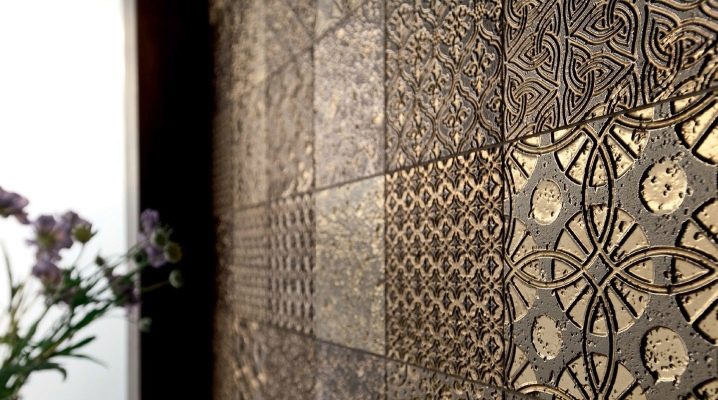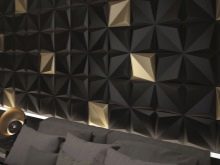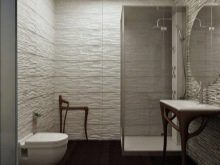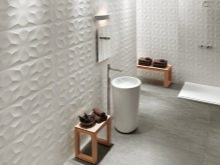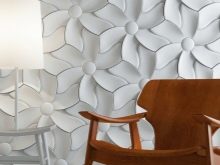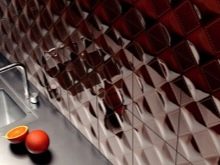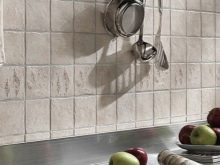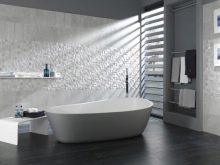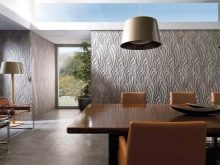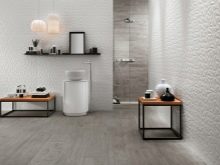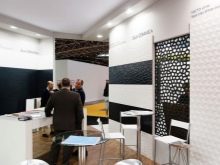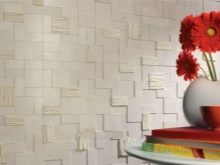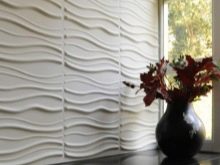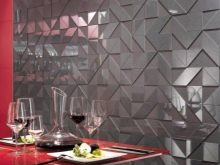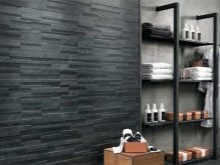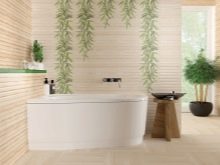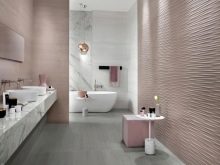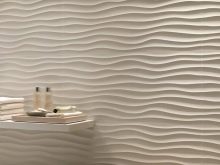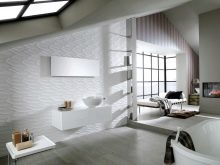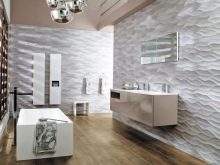Relief tile: features of choice
The market of finishing materials in our time is an abundance of textures, colors and shapes. They allow you to create a unique interior, embody any design decisions and turn an ordinary room into a favorite place to relax.
Among the variety of materials for lining stands ceramic tile, which is used for the bathroom, kitchen or corridor. Being durable and at the same time incredibly beautiful material, it does not lose popularity. Designers often use ceramic tiles to create a canvas, decorate a room with mosaics, or simply add bright accents through large elements. For each purpose a separate type of tile is used, and they all have certain pros and cons.
Advantages and disadvantages
Relief tile differs from the usual inthat its surface has an embossed protruding pattern, which gives additional volume. This texture has several purposes:
- Aesthetics. This tile is difficult to compare with any other material, because it gives the interior a glossy, high cost, it does not look good, but minimalist. It looks appropriate even with a modest design, when there are no unnecessary decorative elements. Volumetric tile attracts all attention to itself, regardless of the style of the interior and the overall orientation. This is one of the few types of this finishing material that looks great in a completely white bathroom.
Smooth options in the design of such an interior will turn the room into a hospital room, and the relief tile will give an expensive look, as if fabulous money was spent on repairing the room. In addition, it helps to visually expand the space due to the abundance of textures and ornaments.
- Convenience. In most interiors, ceramic tile is used not only as an aesthetic, but also quite practical material, since it is able to visually override all the small flaws admitted by masters during installation.Deviations from a given level, initially uneven walls, as well as uneven joints or seams are not a problem for this material.
- Durability and durability. In the production process, the tile goes through several stages of firing and glazing, which allows you to create a material of a monolithic nature without voids with air, which over time destroy the tile. As a result, ceramic tiles are one of the most practical, sturdy and durable materials capable of maintaining their properties for years. In addition, this tile is made of environmentally friendly and safe materials, easily transfers temperature drops and does not absorb water, which prolongs its service life.
An additional advantage is the fact that the volume tile is used in the interior not only of private houses or apartments, but also of various institutions, so that visually impaired or blind people can easily navigate in space.
Of the downsides of using such finishes should be noted complexity when cutting, because you have to carefully select a pattern or pattern when combining two tiles. This is a particularly difficult process for those who do not have enough experience in the walls. Problems may also arise when grouting joints, since this process should be started only after the composition is completely dry.
Sometimes users mention complex care, but this is rather an exception, because the tile is covered with a thick layer of glaze, which makes it easy and without harm to the coating to remove pollution.
It is advisable to get a cleaning cleaner to buy a washing vacuum cleaner or a special brush for trouble-free and quick cleaning.
Kinds
There are the following types of relief tiles:
- Geometry. These are patterns and patterns that repeat different geometric shapes, for example, bricks, squares, or just plain lines.
- Stones. Imitation of stones allows not only to replace expensive natural materials with artificial ones, but also to slightly change the very nature of such an invoice due to interesting colors, various roughness and unusual shapes.
- Folk ornaments. Such options reflect the cultural characteristics of a particular nation, such as, for example, Gzhel, Khokhloma.
- Vegetable world. Plant motifs represent a complete or partial stylization of such natural elements as flowers, stems, leaves, buds, roots or fruits of plants.
If we talk about the types of relief tiles, it can be glossy or matte, depending on the coating. Designers recommend combining relief tiles with ceramic options to achieve the most interesting look.
Structured and textured surface
This type of embossed ceramic tiles is particularly relevant for classic and minimalist interiors, where a high-quality and beautiful coating is required, without bright patterns. Such a product fully supports the style of the interior and becomes part of the overall picture, without standing out from the rest of the background.
Textured tiles are mainly produced with embossed natural materials like stone, wood or leather. It preserves the useful qualities of ceramic tiles, but provides great opportunities for design solutions that require unusual and aesthetically beautiful options. At the same time, the tile is used not only for cladding walls, but also as a floor covering, which makes it possible to quickly and easily choose a version to match or from one collection, without breaking the interior with various options.
In terms of strength, glazed tiles can lose, therefore, only structured versions are used for floor covering.
The floor tile is particularly resistant to mechanical damage, and is therefore used even for external cladding of steps or floors in the open air. The surface with the relief fits perfectly into many interior styles, and there are no slots when laying it.
All the subtleties of laying relief tiles, see the following video.
